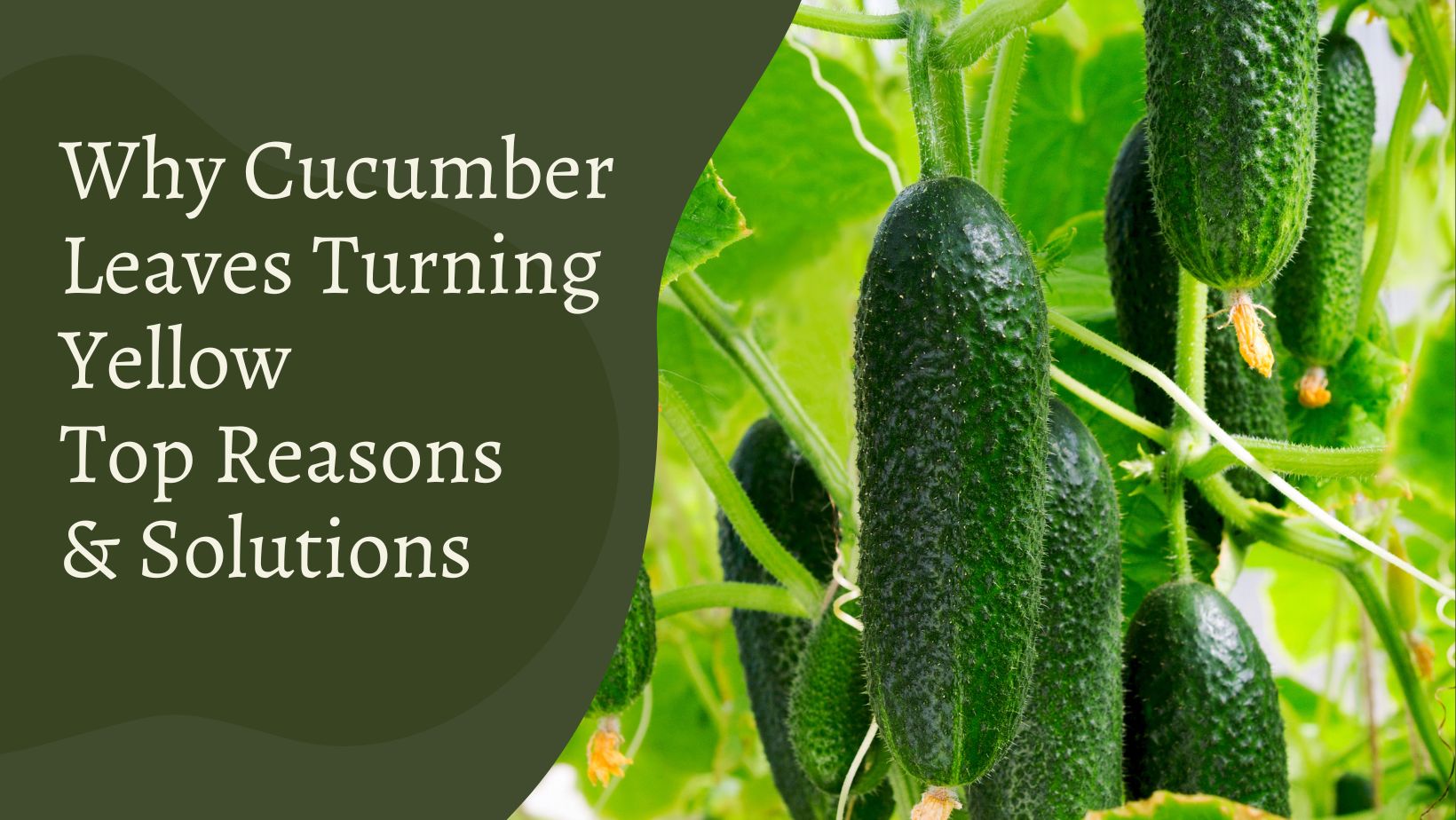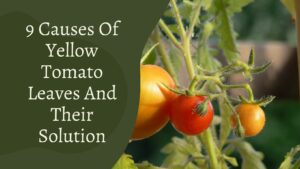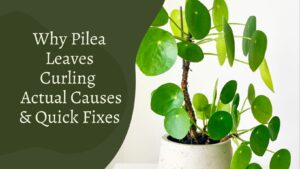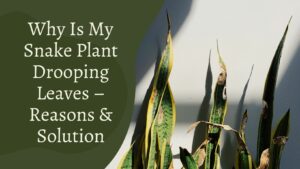
Cucumber leaves turning yellow is a most common problem for many gardeners as cucumbers are one of the most popular plants to cultivate in your garden. They have a wide range of plants that are better for gardeners. Bush, slicing, and vining cucumbers are among these varieties.
Cucumbers for slicing are more bigger and longer. They’re also great in smoothies and salads. Then there are wild cucumbers, which may be found in many countries throughout the world. Then it was suggested that the major cucumbers came from India and other regions of Southern Asia.
Although cucumber is the most beneficial plant, growing it can be difficult from the moment you plant it until it matures (particularly if you have no idea how to care for those plants). Cucumber leaves, thankfully, operate as reporters. The leaves are the first signs that something is wrong with your cucumber plant.
Cucumber leaves that have become yellow or wilted can be seen. Cucumbers are strong feeders and require continuous irrigation, warm and sunny conditions, and fertile soils.
As a result, the type and quantity of nutrients they get determine how effectively they develop. The plants are also susceptible to a range of problems that cause the leaves to become yellow (a disease known as chlorosis) and even death if left untreated.
Nutritional inadequacies, water issues, light problems, plant pests, and plant diseases are the most common causes of cucumber leaves turning yellow, or chlorosis. Let’s look at each of these five factors in more detail:
Nutritional Deficiency
Cucumbers, as previously said, are heavy feeders, which means they require a lot of nutrients to develop and produce effectively. Cucumber plant leaves will turn yellow if any of the essential elements are deficient.
If you want to know if your plant is deficient in any of the key nutrients, you’ll need to get the soil in your garden analysed. The following are some of the most prevalent nutritional deficits that can cause cucumber leaves turning yellow:
Deficiency in Nitrogen
When it comes to plant development, nitrogen is a critical nutrient. Nitrogen deficiency in cucumber plants results in yellowing of the leaves as well as reduced development. In severe circumstances, the disease may finally kill the plant.
As a result, it’s ideal if you keep an eye out for indications of nitrogen deficiency in your garden, as the problem is simple to correct if caught early. Older cucumber leaves will become yellow at the tips or along the centre veins, while fresher leaves will remain green.
Deficiency in potassium
Cucumbers are one of the few plants that require more potassium than nitrogen. Leaves turn yellow at the margins and tips, and fruits have a club-shaped appearance, which are classic symptoms of potassium shortage. Furthermore, the younger leaves are tiny, dull, and puckered or cupped.
Fortunately, this problem may be solved by using a well-balanced fertiliser. If required, you can also treat your soil for alkalinity or acidity.
Deficiency in iron

Cucumber leaves becoming yellow might also be caused by an iron deficit. Iron deficiency might be the reason for young leaves become yellow while their veins and older leaves stay green. Spray liquid iron on the cucumber plant or apply powdered or granular chelated iron to the root zone to correct the deficit.
Deficiency in zinc
Zinc deficiency is most likely the reason older leaves become yellow between the veins. The plant’s development is frequently limited in this instance, and the leaf size is less than usual. Spray the cucumber plant with a Zinc Sulfate solution or use organic kelp to address the deficit.
Plant Insects
Insects that suck the sap from the leaves are among the many types of plant pests. One of the most prevalent causes of leaf browning and yellowing is sap sucking. The following are examples of common plant pests:
Spider mites
These suckers are commonly seen on the undersides of cucumber leaves. Yellow stippling is caused by spider mites.
Aphids
Aphids are little oval-shaped insects that attach themselves to the undersides of cucumber leaves as well. Honeydew is a sticky black substance left on the leaves by these bugs, which are mostly yellow or green in colour.
Whiteflies
Whiteflies, like aphids, hang around on the leaves as a little cloud of white-winged insects and leave honeydew behind. To get rid of these pests, you might choose to use a safe and ecologically friendly pesticide.
Plant Diseases

Plant infections can generate yellow streaks or patches on cucumber leaves in rare circumstances. The following diseases cause yellowing of leaves:
Wilt Fusarium
Cucumber beetle larvae feed on the plant roots, causing the leaves to become yellow around the margins and move inwards, creating illness. Get rid of the affected plants in your garden to manage the illness. Verticillium wilt is another prevalent disease that causes cucumber leaves turning yellow. You’ll likely get this illness if you grow cucumbers with tomatoes, eggplants, potatoes, and peppers.
Cucumber Mosaic
The cucumber mosaic virus generates wrinkles in the plant’s leaves, which curve downward and have yellow dots. To manage the illness, just get rid of the afflicted plants in your vegetable garden, just like Fusarium wilt. It may easily be spread by plant pests like leafhoppers or aphids.
Mildewy Mildew
Another frequent plant disease that might cause your cucumber leaves to yellow is blight. Yellow dots on the upper surface of the leaves that become brown are common symptoms. Plant disease-resistant cucumber cultivars, remove sick plants, and enhance air circulation around the plants to manage and avoid this illness.
Sunlight Isn’t Shining Brightly Enough
Some of your cucumber leaves turning yellow and limp if it doesn’t get enough sunshine. As a result, if your garden is in moveable containers, you should position it in an area with appropriate sunshine or transfer it to an area with sunlight for at least 6 hours every day.
Problems with Water
Water is one of the most important necessities for every plant’s growth. Overwatering some plants, such as cucumber, can cause the leaves to yellow. Overwatering deprives the roots of oxygen, resulting in the yellowing of the leaves and eventual withering. Keep in mind that cucumber plants only need 1 to 2 inches of water every week.
How to treat yellowing cucumber leaves:
Cucumber leaves can turn yellow for a variety of reasons. If cucumbers are overwatered, the soil is poorly drained, or plants need extra fertiliser, they will often display signs of yellowing leaves and curled cucumber vines. Use organic garden fertilisers and water your cucumbers less regularly to avoid these difficulties.
Cucumbers may have a disease or bug problem, such as powdery mildew, if the leaves are yellow and withered. The best course of action is to use organic fungicide spray on cucumber vines to select sick cucumbers before they may infect other cucumbers in the garden. Cucumbers should be treated with organic pesticide if their leaves are becoming yellow and they contain cucumber bugs. This will minimise the amount of cucumber beetles that may hurt your garden in the future by killing harvests.
Cucumber leaves turning yellow care:
Soil:
A well-draining soil is essential to prevent yellowing cucumber leaves, plant diseases like damping off, and other cucumber problems due to the delicate root structure of cucumbers. Roots that turn yellow indicate that the cucumbers are not getting the nutrients they need to flourish if your cucumber plants are not in the right conditions.
When cucumber leaves become yellow, it indicates that your soil may have plant illnesses or cucumber difficulties, such as overwatering, root rot, and drainage problems (among others). Cucumber plants will absorb toxins from the soil and their leaves will turn yellow if their roots do not have adequate oxygen.
If the dirt is causing the cucumber leaves to turn yellow, you should adjust it. Cucumbers will not obtain enough oxygen from the air surrounding them if their roots are hindered by drainage issues, and their leaves will turn yellow as a result. Cucumbers prefer light soils because they like to be able to stretch their roots in all directions.
Light
Cucumbers require a lot of light to grow. The leaves of cucumber plants that aren’t exposed to enough sunshine will turn yellow and eventually perish. Cucumbers that are exposed to insufficient light may develop a bitter or watery flavour and lose their flavour.
Watering
Drought is the most common reason of dry cucumber leaves becoming yellow. Cucumbers need to be watered on a regular basis, but not excessively – approximately an inch of water each week is plenty. Too much water can cause damping off disease, which is a fungus that kills cucumber seedlings from the ground up and prevents them from producing new roots or leaves.
Humidity
Cucumbers require a lot of humidity, and low humidity in the air causes cucumber leaves to become yellow. Cucumbers are a plant that dislikes being left out in the sun.
Fertiliser
An overabundance of fertiliser is one of the most prevalent causes of yellowing cucumber leaves. Excess nitrogen encourages lush green growth, but it also makes cucumber vines and leaves fragile and pale in appearance. Follow these methods to keep cucumber leaves from turning yellow from too much fertiliser:
- Mix soluble nitrogen, phosphate, and potassium into a natural fertiliser blend.
- One cup of fertiliser should be applied to each cucumber plant. More fertiliser will make cucumbers mushy and light in colour. Water thoroughly to let the fertilizer’s nutrients to soak into the soil.
- Regularly water the cucumbers and keep them out of standing puddles of water.
- Cucumber leaves can also become yellow if they are exposed to too much salt. To avoid cucumber leaves turning yellow due to excessive salt, fertilise just once a month rather than every two weeks as with chemical salts, and invest in a rain barrel to collect rainwater for cucumber plants.
Pruning
Cucumber pruning is a common task. Cucumber leaves that are sensitive to disease and pests can benefit from this method, which can either increase leaf growth or lower the size of cucumber leaves that are prone to disease and pests. When deciding where to make cuttings, be cautious not to go too deep into the root system of a cucumber plant, as this may result in the plant becoming yellow due to a lack of water.
Should I cut of yellow cucumber leaves:
Cucumber leaves becoming yellow is not a sickness; it simply means the cucumbers are getting older and the plant requires more room. It does not imply that cucumbers are infected with illnesses or pests. You can remove cucumber leaves if you like, but it’s not necessary because cucumber plants just require cucumbers to thrive.
Spot on cucumber leaves:
Cucumber leaves with rusty patches should not be neglected. In a matter of days, a vibrantly green cucumber garden can change into a depressing sight, signalling the end of the hope of crisp cucumbers. Sunburn markings emerge on the leaves as brown or dark yellow dots. Burns are frequent, but they’re nothing to be afraid of. The burned plants will disperse and continue to develop; all you have to do now is water the bushes carefully, avoiding getting water on the leaves. Rust arises on cucumbers as a result of a fungal infection.
Cucumber leaf spot is also known as angular cucumber leaf spot. Pseudomonas syringae pv. lachrymans is the bacteria that causes it. Pseudomonas syringae may be found on cucumbers as well as other vegetables such as zucchini squash and honeydew melon.
Is it possible to eat yellow cucumber?
Yes, they are harmless, but you are unlikely to consume them due to their unpleasant flavour. They have a harsh flavour that is unappealing. Because they are so old, overripe cucumbers that have been growing for a long time are bitter and unpleasant to eat. There are, however, a few different ways to prepare them. Yellow cucumber relish is an excellent way to use them since the pickled components mask the bitterness of the cucumber.
How to prevent yellow cucumber:
When Should You Pick a Cucumber. The majority of cucumbers are eaten when they are still young. Cucumbers may be plucked at any time as long as they aren’t too seedy or have firm seeds.
You may want to pick smaller cucumbers rather than letting them to grow on the vine since thinner cucumbers contain fewer seeds than broader cucumbers. The bulk of cucumbers are chosen based on their length, which varies from 2 to 8 inches (5-20 cm).
When to choose a cucumber depends on the type of cucumber and its intended usage. Pickling cucumbers on the other hand, are much smaller than their slicing counterparts since they are bred specifically for pickling. Cucumbers should be harvested every other day at the absolute least because of their rapid growth rate.
Overwatering should be avoided.
Even during a prolonged drought, cucumbers only require two inches of water each week. Even if there is a lot of rain, you should only use 1 inch of water every week. This equates to around six to twelve gallons per square foot of soil. Water your plants gently and deeply twice a week, but not excessively, for the greatest effects.
Cucumber Mosaic Virus must be eradicated.
It’s critical to halt the spread of the cucumber mosaic virus. Cover cucumber seedlings with permeable fabric row coverings while planting.
They’re light enough to raise, allowing air, light, and moisture in while keeping virus-carrying aphids out, allowing them to remain outside.
What Is Causing My Cucumber Seedlings To Fall Over?
Leggy seedlings are caused by a lack of light at their most fundamental level. It’s possible that the window where you’re growing your seedlings doesn’t get enough light, or that the grow lights you’re using aren’t close enough to the seedling. The seedlings will get leggy in any case.
Brown spots on cucumber leaves:
![]() Brown patches on cucumber leaves are caused by Alternaria infections. Anthracnose causes dark patches on the leaf to fall off, creating holes. Bacterial leaf spot appears on the underside of leaves as little brown patches. Between the leaf veins, angular leaf spot disease creates light tan brown patches.
Brown patches on cucumber leaves are caused by Alternaria infections. Anthracnose causes dark patches on the leaf to fall off, creating holes. Bacterial leaf spot appears on the underside of leaves as little brown patches. Between the leaf veins, angular leaf spot disease creates light tan brown patches.
Leaf Spot on Alternaria On cucumber plants, Alternaria leaf spot is a fungal foliage disease. It is resistant to just a few types. It can spread to the fruit of other cucurbits like cantaloupe and watermelon, although only the leaves of cucumber plants are affected.
Small brown patches on mature leaves with a yellow halo (ring) around the margin are the first signs. The spots are small at initially, measuring one to two millimetres in diameter. However, as the illness progresses, those spots get larger, reaching a half-inch in diameter each spot.
As the illness spreads and the spots get larger, all of the older leaves will turn brown, culminating in defoliation. Brown leaf tips are the first evidence of spread on fresh leaf development.
Anthracnose
Anthracnose damages cucumber leaves in the same way as the Alternaria fungus does, only the spots dry up and fall off, leaving holes in their wake.
The brown spots begin tiny and can grow to be comparable in size (half an inch in diameter), but as the necrotic spots dry, they fall out of the leaf, leaving a hole.
Multiple necrotic patches might appear on anthracnose-infected leaves.
When it spreads, cucumber plants’ leaves take on a shot-hole look, as if something has eaten holes out of them.
The leaves will be dry and brittle, with brown brittle edges around the holes.
The wetter the leaves become and the longer they stay wet, the more likely this is to become a problem.
Bacterial leaf spot
Bacterial leaf spot is a bacterial infection, as the name indicates. These are simpler to spread than a fungus and can reach the fruit.
Bacterial leaf spot is just the beginning of the illness. It first shows up on the undersides of leaves. Because the dots are tiny, around a half-centimeter in diameter, they are difficult to see.
A way to tell if you have this kind of brown spot is to look for leaf damage on a regular basis. The yellow dots on cucumber leaves are caused by mite damage on the underside of the leaves, which makes them look yellow. Bacterial leaf spots are holes that are the same size on the underside of leaves that are brown. As long as the bacteria aren’t cut off from the leaf, they can spread to the stem and eventually to the rest of the plant, including the fruit, if they aren’t stopped.
To prevent the infection from spreading to other plants, disinfect equipment with rubbing alcohol that is at least 70% isopropyl before pruning away the affected areas of the plant.
Angular Leaf spot
Anthracnose infection resembles angular leaf spot in appearance. Pseudomonas syringae pv. Lachrymans is the bacteria to blame.
Water lesions form on the underside of leaves but do not spread beyond the veins of the leaves. In the veins of the leaves, the dots will be concentrated.
The dots start off yellow and gradually turn a tan brown colour. Similar to anthracnose, the centre of the spot dries and falls off the leaf, giving it a shot-hole appearance. Take a look at the hole’s edge if this happens.
Conclusion :
Most other plants are more difficult to grow than cucumbers. As a result of this, its leaves can turn yellow or even dry out. Insufficient soil, cucumber-specific illnesses and pests, irrigation issues, and a lack of sunlight are just a few of the causes for yellowing in cucumber plants. Depending on the situation, there are a variety of remedies. Knowing what to look for and how to assist your cucumber plants grow and thrive will be easier if you have the right information.

Hi This is Maria, We are a team of gardening enthusiasts with a passion for gardening. We have tried to bring you tips and advice enabling you to grow and maintain a healthy and beautiful garden. We Hope You Find it Useful.






